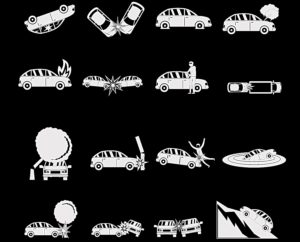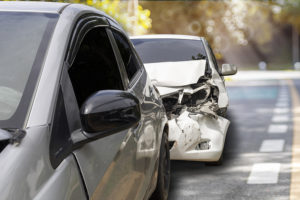 Car crashes are so common that we think of them as part of everyday life. Yet for those involved in them, each car crash is traumatic and dangerous.
Car crashes are so common that we think of them as part of everyday life. Yet for those involved in them, each car crash is traumatic and dangerous.
Car insurance experts estimate that the average driver will file a claim for a car accident about once every 17.9 years or about three to four accidents during your driving life. Industry experts who analyze car accidents track many factors.
Because accidents occur in so many different ways, with overlapping causes, statistics often look at contributing causes, rather than one cause of any given car accident.
This type of research and statistics, such as that performed by the National Highway Traffic Safety Administration’s Office of Vehicle Safety Research, aims to reduce crashes, injuries, and fatalities.
Car Crashes in Philadelphia

According to the National Highway Traffic Safety Administration (NHTSA), 37,133 people died in motor vehicle crashes in 2017, which is the first decline since 2014.
Fatalities decreased for many types of accidents, including those involving impaired driving and accidents related to speeding.
The Pennsylvania Department of Transportation reports that in 2017, there were 128,188 reportable traffic crashes and 1,137 traffic accident deaths in Pennsylvania.
At least three people died in traffic accidents each day, on average. Approximately 9 percent of these accidents and 8 percent of the fatalities took place in Philadelphia.
Many types of accidents happen on Pennsylvania roads, but some are more frequent than others. Most accidents took place when drivers crashed into fixed objects, such as trees or guard rails. Other common types of accidents included rear end collisions and angled collisions.
According to the National Highway Traffic Safety Administration, failure to stay in the proper lane, and failure to yield the right of way were also common, accounting for almost 15 percent of all drivers in fatal crashes.
Common types of car accidents include:
- Hit fixed object (37,825 crashes; 402 fatalities). Drivers frequently hit trees, utility poles, and traffic barriers. Alcohol is often involved and about fifty percent of these crashes occur at night.
- Angle crashes (34,823 crashes; 247 fatalities). These crashes usually take place in parking lots or when two vehicles pass on a road.
- Rear end crashes (28,786 crashes; 81 fatalities). A traffic accident where a vehicle crashes into the vehicle in front of it. These often take place because the driver is distracted or simply not paying attention. Other causes include sudden stops and reduced traction due to irregular road conditions caused by weather.
- Sideswipe crashes (8,357 crashes; 62 fatalities). Sideswipe accidents happen when two vehicles are driving next to one another in the same direction collide. These accidents often occur when a driver makes a lane change without being sure the other lane is clear.
- Head on crashes (4,715 crashes; 122 fatalities). Head on crashes happen when two vehicles going in opposite directions have a front end collision. These accidents are often fatal.
- Non-collision crashes (4,234 crashes; 66 fatalities). These situations happen when a vehicle crashes without hitting something, or where the injuries were not caused by the impact, such as overturns, jackknifes, or fires.
- Car/pedestrian crashes (3,970 crashes; 136 fatalities). When a vehicle hits a pedestrian, the pedestrian is almost always the most severely injured.
- Backing up crashes (410 crashes; 1 fatality). Back-up collisions happen when a driver reverses the car into an object, person, or another car.
- Other crashes (5,068 crashes; 20 fatalities).
TOTAL crashes 128,188 crashes; 1,137 fatalities.
Researchers also investigate the pre-crash event, which means the vehicle movements and the critical event that occurred immediately before a crash. Approximately 36 percent of the vehicles were turning or crossing intersections just before the collision. About 22 percent of the vehicles ran off the edge of the road and 11 percent failed to stay in their lane. About 9 percent lost control of their vehicle before the crash.
Types of Car Accidents in Philadelphia
Just as our firm handles motor vehicle accidents caused by a wide variety of factors, we also represent clients who sustained their injuries and losses in every conceivable type of car accident.
Here are some of the most common types of collisions and wrecks for which our team helps our clients recover compensation.
Rear-end Collisions
Rear-end collisions are one of the most common types of accident and also the most likely to result in an injury to drivers, passengers, or others. Rear-end collisions occur when the front end of one motor vehicle collides with the back end of another motor vehicle.
This type of accident is often referred to as a fender bender, and is generally considered a relatively minor type of auto collision. However, even “minor” low-speed accidents can cause severe injuries to drivers and passengers, particular in the form of back, neck, and brain trauma.
Of course, when rear-end collisions happen at high speeds, far deadlier results can ensue. For instance, if two cars travel at highway speeds of 55 miles per hour or more and one car suddenly slams on its brakes, the rear car may not have time to brake at all before it crashes into the front car. This means that a vehicle driving at fast speeds may hit a completely or nearly stopped car with almost no warning. You can imagine the extent of the damage and injuries this may cause to occupants of both vehicles.
Rear-End Collisions and Commercial Trucks
Rear-end accidents only become more severe when a commercial truck is involved. If a commercial truck collides into the back of a small passenger vehicle, the 80,000-pound truck often has enough weight to simply drive over and crush the small car. This is commonly referred to as an override accident—and it’s usually deadly.
In addition, if a small car collides with the back of a commercial truck, it can get stuck under the back of the trailer. This is referred to as an underride accident, and can instantly kill any motorists in the front of the car if the windshield collides directly with the back of the truck. Though trucks are required to have underride guards to prevent this type of accident, many of these guards are not effective at keeping cars from driving under the trailer.
Angular Collisions
Angular collisions, such as when one car T-bones another car at an intersection, are considered the most fatal category accident.
Angular crashes are so deadly because they subject human bodies to violent, twisting impacts that cause significant internal trauma and limit the effectiveness of motor vehicle safety systems like airbags and shoulder restraints. Another reason is that angular crashes, particularly 90-degree T-bone collisions, have the potential to crush drivers or passengers sitting nearest to the point of impact.
Unlike in a head-on collision, in which the front end of a car absorbs a significant amount of force by crumpling, doors and windows contain mere inches of material separating drivers and passengers from an outside force. Older vehicles don’t have side airbags to cushion the impact.
Angular crashes may also have a higher likelihood of involving at least one vehicle traveling at high speed, because drivers can turn into the path of oncoming traffic without seeing it.
Head-On Collisions
Head-on crashes represent a relatively rare type of vehicle-on-vehicle accident, but they account for a disproportionately large share of traffic fatalities because the force of a head-on collision is enormous. Two cars traveling at 45 miles per hour colliding head-on impart roughly the same amount of force on each other at impact as a single car driving into a wall at 90 miles per hour.
Fortunately, automakers have designed cars and trucks to withstand head-on collisions for years. The standard safety features of most cars on the road today include front crumple zones, airbags, and seatbelts, all of which are particularly effective in head-on collisions. Unfortunately, because of the massive forces involved in a head-on collision, any failure of these systems can result in catastrophic injuries.
Anyone not wearing a seatbelt in a head-on collision runs a risk of death after ejection from the vehicle or becoming trapped in a life-threatening position inside a mangled wreck. Even when all of the safety systems work perfectly, a head-on collision at highway speed involves such an extreme force that drivers and passengers may not survive the impact.
Single-Vehicle Accidents
Although vehicle-on-vehicle collisions like the ones above tend to make up a majority of all accidents, and accidents resulting in non-fatal injuries, they are not typically the most deadly broad category of accidents overall. Instead, the majority of all fatalities on U.S. roads tend to result from accidents involving just one vehicle.
Collisions With Fixed Objects
Drivers who lose control and strike a fixed object run a high risk of losing their lives. Many fatal accidents involve vehicles striking fixed features like ditches, trees, telephone poles, bridge abutments, and embankments.
The reason these accidents are so deadly is that with a fixed object, the vehicle and its occupants tend to absorb most of the force of the impact. Fixed-object collisions often happen off of the road surface, increasing the likelihood of an impact at an odd angle or against an object with an unusual shape, reducing the effectiveness of vehicle safety features like airbags and crumple zones.
Rollover Accidents
Although they do not account for a large percentage of total accidents on U.S. roads each year, rollover accidents are some of the deadliest. Rollover accidents happen when something triggers a car or truck to roll onto its side, onto its roof, or even roll several times. During the cause of a rollover accident, all occupants of the vehicle may experience many different points of impact and risk ejection from the vehicle. Despite side airbags, seat belts, and other safety features, victims of rollover accidents often suffer severe injuries.
Cars don’t roll over very often, and when they do, they sustain severe damage. Rollovers may indicate a catastrophic failure of an auto part or of a very unusual road condition. In either case, proving how the rollover occurred and who should bear fault may require significant levels of experience and diligence. Victims of rollover accidents should consult an experienced Philadelphia car accident attorney who can investigate and litigate these challenging cases.
Hit and Run Accidents
Under Pennsylvania law, it is illegal for a driver in a car accident resulting in injury, death, or significant vehicle damage to leave the accident scene before law enforcement arrives. It is also illegal for a driver in any other kind of accident to leave the scene before exchanging information and giving necessary aid.
Victims of hit-and-run accidents face what may feel like a hopeless situation: waiting for law enforcement to identify the person who committed the violation and then holding that person accountable for injuries and losses.
Drivers may flee accident scenes because they fear the consequences of their actions. When they do so because they were driving a work vehicle and fear losing a job, the employer may well bear liability to the accident victims. Consult a skilled car accident attorney to help determine who may be responsible for compensating you when you are the victim of a hit-and-run.
Ridesharing Accidents
Ever since ridesharing apps like Uber and Lyft burst onto the scene a few years ago, Philadelphians have embraced the efficiency and convenience of summoning a private car to take them where they need to go. Unfortunately, the advent of ridesharing has also introduced new and tricky problems for victims of accidents involving ridesharing vehicles.
For example, the insurance coverage available to victims of an Uber or Lyft driver’s negligence may depend on whether the driver was transporting a passenger (or on his way to pick one up) at the time of an accident. Many victims of ridesharing accidents also assume that the companies themselves will pay for a driver’s negligence, but because Uber and Lyft treat drivers as independent contractors, that may not happen.
If you sustained injuries in an accident involving an Uber or Lyft driver, whether as a rideshare passenger, as the driver or passenger in another car, or as a pedestrian or cyclist, hire experienced legal counsel. The laws concerning liability for Uber and Lyft drivers continue to evolve, posing a challenge to victims and their families.
Uninsured and Underinsured Motorists
Pennsylvania law requires auto insurance companies to offer drivers the option of purchasing insurance against uninsured and underinsured motorists. When drivers purchase this insurance, their own policy covers them in the event of an accident in which the other driver is at fault but does not have any or enough insurance to cover the damages the accident caused. This coverage can also protect drivers who sustain injuries and losses in a hit-and-run accident in which the authorities never apprehend the offending driver.
Making an uninsured or underinsured motorist claim against your own insurance policy may require that you take specific steps to preserve your right to compensation, such as by filing a written police report and putting your insurance carrier on notice of the accident. An attorney with experience representing victims of Philadelphia car accidents can help review the fine print of your insurance coverage and ensure you follow the process to the letter. An attorney can also help you identify any other potential sources of recovery.
Were You Injured In A Pennsylvania Car Accident?
When you are involved in a car accident, your first concern should be your own well-being and getting the medical care you need. Then you wonder exactly what happened and who is responsible. If you have been injured in a car accident in Pennsylvania, you may be legally entitled to recover compensation from the at-fault driver. The car accident laws of Pennsylvania will govern your lawsuit.
Personal injury law is generally based on negligence. The legal theory of negligence is defined as “a failure to behave with the level of care that someone of ordinary prudence would have exercised under the same circumstances.”
It may consist of actions, but in some circumstances may also consist of omissions. Simply put, the law of negligence requires a driver to operate the vehicle with reasonable care. A driver who fails to do so is negligent and can be held liable for any resulting injuries. Damages may include claims for current and future medical expenses, lost wages or diminished employment opportunities, pain and suffering, or loss of affection (also called “loss of consortium”).
Pennsylvania’s car insurance law is more complex than most state laws. Pennsylvania has adopted a unique choice “no-fault” system for car accidents and insurance claims. When someone purchases insurance, they must choose between two types of insurance coverage. These are full tort or limited tort (no-fault). Under the no-fault option, in most cases, if the person is in an accident, they will not be able to file a lawsuit to get compensation. Instead, they will file a claim with their own insurance provider, even if they were not at fault.
What if you file a personal injury lawsuit to recover compensation for injuries suffered in a car crash, but you are partially at fault. In that situation, Pennsylvania’s comparative fault laws may affect your case. These laws dictate how much you can recover in a crash that you were partially to blame for, or even whether you will be allowed to recover anything, at all. Pennsylvania uses a modified comparative negligence law. This law allows you to recover damages as long as the amount of your fault was not greater than that of the other driver.
Recovering a large monetary award for your damages cannot give you back your loved ones or the life you had before suffering a severe injury. But it can help you face the financial consequences of your accident and give you the best possible future. All states have time limits for filing lawsuits.
Under Pennsylvania’s statute of limitations for cases that stem from personal injuries or property damage suffered in a car accident, you must file your lawsuit before it expires. These limits are applied strictly, so complying with this rule is critical because if you fail to file your case before the time limit ends you will probably lose your right to file a claim for the accident. Therefore, you should consult an experienced personal injury attorney as soon as possible.
